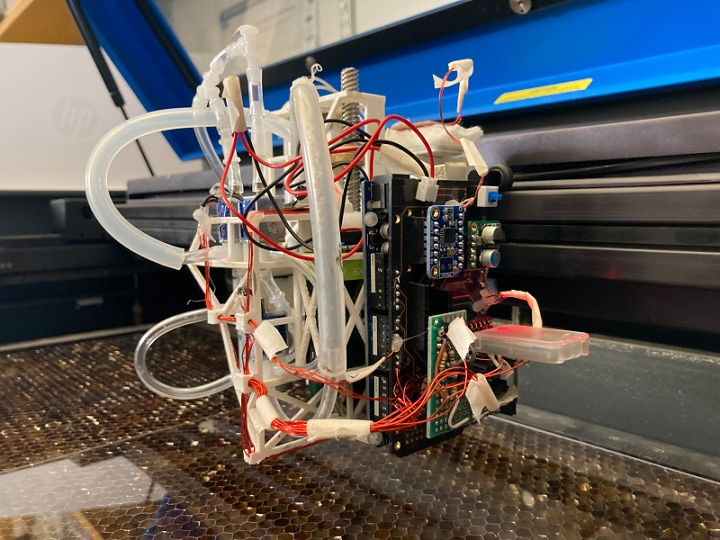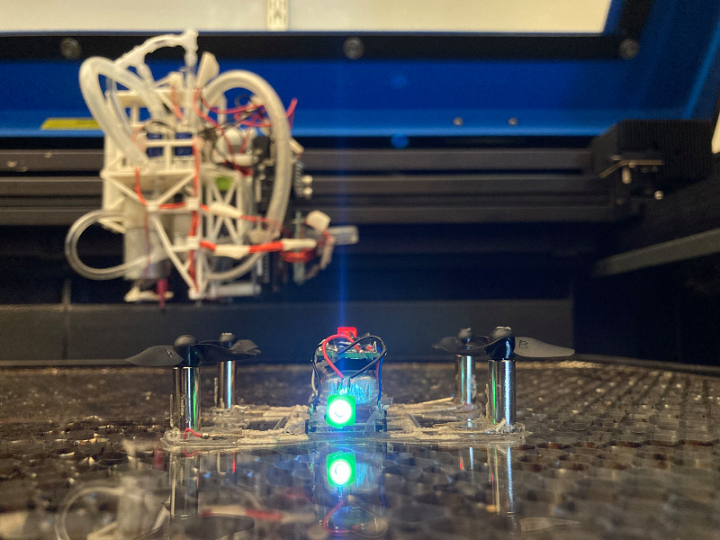 (Source/Images: MIT CSAIL)
(Source/Images: MIT CSAIL)Talented researchers with MIT’s Computer Science and Artificial Intelligence Laboratory (CSAIL) have long worked with robotics, and a CSAIL team recently announced their development of a new system, called LaserFactory, that is able to automatically fabricate functional, custom devices, like robots, without human intervention in the process. In fact, the researchers say that the complex devices they print on the system, such as drones, can come off the print bed and immediately get to work, which would be extremely helpful in applications such as search-and-rescue or delivery.
The system works by using a three-ingredient recipe which allows for the creation of structural geometry, and lets users print traces and assemble electronic components, such as actuators and sensors. A software toolkit that lets users design custom devices, plus a hardware platform that prints them, are the two parts of LaserFactory that work synchronously to build these functional drones in one step.
“Making fabrication inexpensive, fast, and accessible to a layman remains a challenge. By leveraging widely available manufacturing platforms like 3D printers and laser cutters, LaserFactory is the first system that integrates these capabilities and automates the full pipeline for making functional devices in one system,” said CSAIL PhD student Martin Nisser, the lead author on a paper about LaserFactory that will appear in the ACM Conference on Human Factors in Computing Systems in May.
The team’s research is based upon work supported by the National Science Foundation (NSF), and received further support from a Microsoft Research Faculty Fellowship and The Royal Swedish Academy of Sciences.
So, here’s how the LaserFactory can create a fully functioning drone: first, a user would design the device by selecting and placing components from a parts library, and then draw on the circuit traces, which allow electricity on a PCB to flow between the electronic components. A 2D editor is used to complete the drone’s geometry, such as adding batteries and propellers, wiring them to form electrical connections, and drawing a perimeter that will set its shape.
Then, the user has the chance to see their design before it’s translated by the software into a custom blueprint for machine instructions. In order to make the device in one fell swoop, the commands are embedded into one fabrication file, and an add-on is clipped onto the laser cutter that can print circuit traces and assemble components. LaserFactory then automatically cuts the geometry, dispenses silver for circuit traces, picks and place components, and makes the traces conductive by curing the silver. The final fabrication step is securing the components into place on the device.
The whole process is shown in the short video above, and you can actually see the fully functional drone lift itself off the hardware and fly into the air; it’s pretty cool.
As far as next steps go, the CSAIL research team is hoping to enhance the resolution and quality of the circuit traces, so they can print denser, more complex electronics. In addition, they’re hoping to use the LaserFactory as a jumping-off point to figure out how to create a wider range of 3D geometries, which would require integrating traditional 3D printing techniques.
“Beyond engineering, we’re also thinking about how this kind of one-stop shop for fabrication devices could be optimally integrated into today’s existing supply chains for manufacturing, and what challenges we may need to solve to allow for that to happen. In the future, people shouldn’t be expected to have an engineering degree to build robots, any more than they should have a computer science degree to install software,” Nisser said.
 (Source/Images: MIT CSAIL)
(Source/Images: MIT CSAIL)Subscribe to Our Email Newsletter
Stay up-to-date on all the latest news from the 3D printing industry and receive information and offers from third party vendors.
You May Also Like
3D Printing News Briefs, April 13, 2024: Robotics, Orthotics, & Hypersonics
In 3D Printing News Briefs today, we’re focusing first on robotics, as Carnegie Mellon University’s new Robotics Innovation Center will house several community outreach programs, and Ugogo3D is now working...
Rail Giant Alstom Saves $15M with 3D Printing Automation Software 3D Spark
3D Spark has entered into a three-year deal with the rail giant Alstom. Alstom, a transport behemoth with annual revenues of $16 billion, specializes in the manufacture of trains, trams,...
Meltio Expands Global Reach with New Partnerships in the Americas and Europe
Spanish 3D printing manufacturer Meltio has expanded its sales network across the globe. With the addition of three new partners in the United States, Brazil, Argentina, and Italy, Meltio aims...
3D Printing Webinar and Event Roundup: April 7, 2024
Webinars and events in the 3D printing industry are picking back up this week! Sea-Air-Space is coming to Maryland, and SAE International is sponsoring a 3D Systems webinar about 3D...
































